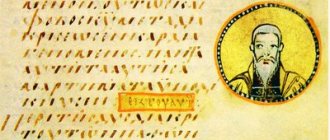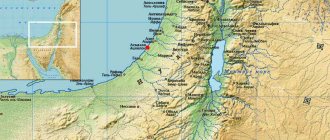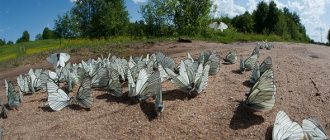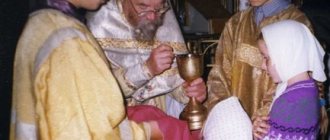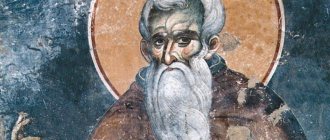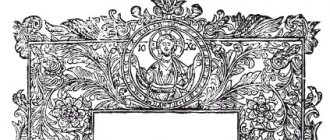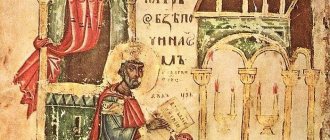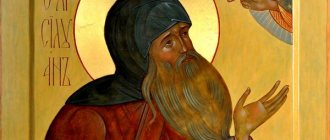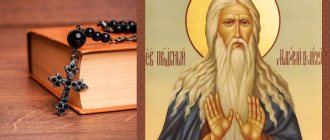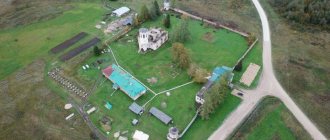| Venerable Neil of Sorsky |
Nil of Sorsky
(+ 1508), venerable, founder of the movement of non-covetous people Commemorated on May 7 on the day of death, in the Cathedrals of the Athos venerable and venerable Russian Svyatogortsy
He came from the boyar family of the Maykovs. He accepted monasticism at the monastery of St. Kirill of Belozersky, where he used the advice of the pious elder Paisius (Yaroslavov), later abbot of the Trinity-Sergius Lavra. Then the monk wandered for several years with his disciple, the monk Innocent, around the Eastern holy places and, having lived for a long time in the Athos, Constantinople and Palestine monasteries, returned to the Cyril Monastery on Beloozero.
Retiring from there to the Sora River in the Vologda land, he set up a cell and a chapel there, and soon a desert-dwelling monastery grew up around them where the monks lived according to the monastic rules, which is why Saint Nile is revered as the head of the monastic life of the monastery in Russia. According to the covenant of the Monk Nile, in his famous charter drawn up in the image of the East, monks were to feed on the labor of their hands, accept alms only in extreme need, and avoid the love of things and luxury even in church; women were not allowed into the monastery, monks were not allowed to leave the monastery under any pretext, and ownership of estates was denied. Having settled around a small church in honor of the Presentation of the Lord in the forest, in separate cells of one, two and no more than three people, the hermits on the eve of Sundays and other holidays gathered for a day for Divine services, and an all-night vigil, at which two or three were offered for each kathisma readings from the patristic works continued all night. On other days, everyone prayed and worked in their cell. The main feat of the monks was the struggle with their thoughts and passions, as a result of which peace is born in the soul, clarity in the mind, contrition and love in the heart.
In his life, the holy ascetic was distinguished by extreme non-acquisitiveness and hard work. He himself dug a pond and a well, the water of which had healing powers. For the holiness of Elder Nile's life, the Russian hierarchs of his time deeply revered him. Reverend Neil was the founder of the non-covetous movement. He participated in the Council of 1490, as well as at the Council of 1503, where he was the first to vote for the monasteries not to have villages, but for the monks to live by the labor of their hands.
Avoiding the honors and glory of this world, before his death he commanded his disciples to throw his body to be devoured by animals and birds or to bury him without any honors at the site of his feat. The saint died at the age of 76 on May 7, 1508 [1].
Life path of Nil Sorsky
Before the birth of Nil Sorsky, there were only two types of monasticism - cenobitic and hermitic. With a communal structure of life, the monks lived in common cells and ran a joint household. The hermit lifestyle did not allow proximity to other people. The hermitage of the monastery meant that the monks would live close to each other, despite the fact that they labored separately.
Interesting to know! The concept of “to strive” in Orthodoxy means to perform a feat or a good deed for the good of one’s soul.
Little information has come down about the Saint’s childhood and youth. It is known that he was born around 1433. The monk himself said that he was born into a poor family, was uneducated, his parents were simple peasants and could not give their children an education.
However, the wisdom of the Saint, his reasoning, atypical for a peasant, and knowledge in various fields of science and spheres of life suggest that in fact Nil of Sorsky came from a noble family.
Venerable Neil of Sorsky
It is known that before taking monastic vows he was engaged in rewriting books. Endless humility and detachment from worldly affairs could be the reason why the elder hid his origin.
Interesting to know! Historians believe that the righteous man came from the noble family of the Maykovs.
Nil Sorsky began his path as a hermit in the Kirillo-Belozersky Monastery. Elder Paisiy Yaroslavov, who lived in this monastery, taught young monks the skills of ascetic life. Here the monks learned the basics of monastic life, learned to pray, worked incessantly, and observed fasts.
Despite his young age, the name of Nil Sorsky is often mentioned in the chronicles of the monastery, along with the revered elders. The monk took part in household affairs and was engaged in rewriting books.
Neil lived a good time in the monastery, he was not burdened by the monastic way of life, but after some time the ascetic, together with his disciple, went on a journey to holy places. Their journey lasted a long time; the monks managed to visit many monasteries and temples before they reached Athos.
Hagiographic icon of St. Nile of Sorsky
Nil Sorsky lived on Athos for quite a long time. The Nile learned from the wise Athonite elders the experience of living in the desert. During this time, he fell in love with solitude, imbued with a feeling of peace and joy from spiritual contemplation.
The heart of the ascetic strove for sacred silence, because in the desert the righteous man first of all sought not solitude, but God. Here Nilus of Sorsky learned Greek and read many works of the Holy Fathers of the Church.
Returning to his native lands, Neil decided to live not in the monastery, but in a desert area nearby. In the new place, the righteous man erected a cross, built a modest hermitage, and dug a small well. Here Nil Sorsky began a new life in prayer and solitude.
Interesting to know! The place that the ascetic chose to perform his hermit’s feat was located next to the Sorka River. That is why the righteous man in the future began to be called Nile of Sora.
Young monks flocked to the righteous man for wise advice and instructions. Every year there were more and more of them, so it was decided to build a wooden church next to the primate’s house. At the site of the future temple, a stone embankment was first made, since it had to be built in a swampy area.
Nilo-Sorskaya desert in the Vologda region
Through joint efforts, the temple was erected in a short time. The life and way of life of the monks of the new monastic monastery was based on the example of the ascetic life of the Athonite elders. As in any monastery, the life of the monks was spent in work and prayer. Arriving at the monastery, the monks refused any household goods or material property. The brothers spent all their free time studying the Holy Scriptures, praying and worshiping.
Interesting! Divine services at the monastery of Nil Sorsky were strict and as complete as possible; for example, the all-night service actually lasted the whole night.
Reverence
The relics of Saint Nile, buried in the monastery he founded, became famous for many miracles. The Russian Church canonized him as a saint.
In the legends of the Nilosorsky monastery there is a legend that during a visit to the Beloezersky monasteries, Tsar Ivan the Terrible was in the Nilosorsky monastery in 1569 and ordered to found a stone one instead of the wooden church built by the Monk Neil. But, appearing to John in a dream vision, Saint Nile forbade him to do this. In return for the unfulfilled enterprise, the sovereign granted the monastery, with his own signature, a document granting the monastics a monetary salary and bread salary. This certificate has been lost.
Confrontation with Joseph Volotsky
Nil Sorsky led the monastery all his life and rarely left it. In 1491, the elder participated in the Council dedicated to opposing the Judaizing heresy. By that time, the ascetic had gained nationwide fame as a highly spiritual person, and even the highest spiritual ranks listened to his opinion.
With his help and with the participation of other defenders of Orthodoxy, pockets of heresy were suppressed. Paisiy Yaroslavov especially warmly supported the ascetic’s opinion at the council. The respected elder from the Kirillo-Belozersk monastery agreed with his student in everything.
At the first council, the first conflicts arose between Nil of Sorsky and Joseph of Volotsky. Nil Sorsky and his followers sharply condemned any manifestations of heresy, but did not demand the application of capital punishment to its distributors. Many of them were deceived; some apologists of the erroneous religious movement should have been imprisoned, thus isolating them from society.
Joseph Volotsky and Nil Sorsky
Nil Sorsky considered the death penalty to be too cruel a method of struggle. Joseph and Gennady Volotsky adhered to radical measures against heretics - all distributors of heresy were supposed to be executed by burning out such an “infection” with a hot iron. In their opinion, any other methods of struggle would be ineffective.
Nil Sorsky was far from the problems of the laity, he was internecine proceedings and the mood of the authorities. The righteous man believed that Christian repentance was enough not to punish a person for erroneous judgments. Only those who were especially stubborn were supposed to be punished, so that they would not confuse fragile minds with erroneous teachings. Supporters of Nil Sorsky called the “Osifans” excessively cruel, arguing that by such actions they themselves were taking the path of the Judaizing heresy.
Interesting to know! The concept of the Judaizing heresy in Orthodoxy unites several religious movements, mainly concentrated in Novgorod and Moscow.
This period was unique for Rus' in the Middle Ages, when only residents of other countries could adhere to a different religion on Russian lands. Heretical movements arose among traders who visited other countries themselves and communicated with foreign merchants coming to Russia.
That is why Novgorod and Moscow became the center of spiritual confrontation - cities that were the largest shopping centers of Rus'. It was difficult for the authorities to keep track of what exactly visiting scribes were preaching to ordinary people, despite the fact that foreigners were prohibited from carrying out missionary activities on the territory of the Russian state. The Judaizing heresy arose after the mixing of Christian and Jewish dogmas.
Nil of Sorsky at the Church Council of 1503
The elder visited the Council for the second time when the issue of the monastery property was discussed. The primate sharply criticized supporters of monastic land ownership. He believed that monasteries could not own villages and large plots of land.
All the monks of his monastery fed on their own labor. Any concern for profit is contrary to monastic feat. The opinion of the ascetic was warmly supported by the monks of the Belozersk wasteland. On this basis, a heated dispute arose again between Nil Sorsky and Joseph Volotsky.
The divergence in the views of the primates of the Church of those times worsened, and the formation of opposing church groups began to emerge in the church hierarchy. The Monk Joseph zealously defended the monastery's right to own lands and property, believing that this had nothing to do with money-grubbing.
He said that church properties make the Church more independent from the state. Material resources that came into the possession of the Church made it possible to build new churches and carry out charitable activities. Ultimately, the opinion of Joseph Volotsky prevailed at the council.
Important! Joseph Volotsky is a leader of the Russian Orthodox Church, a talented church writer, and patron of Orthodox economics. Canonized and venerated as a Saint since 1579.
The conflicts that arose in the church environment reflected the processes taking place in the young Russian state. There was a period of autocracy in Rus', which was associated with difficult issues of distribution of power and property.
Blessed death
Before his death, Saint Nil of Sora gave his last instructions to the brethren.
Regarding his future funeral, he said that he was not worthy of an honorable burial, as a sinner, he called on his disciples to throw his body in the desert, to be devoured by wild beasts, or to bury it with contempt in a hole. At the same time, he added that just as he tried not to use honor on earth, in this life, so he would like it to be the same after his death.
On April 7, 1508, the saint peacefully departed to God. The holy relics are in his desert, hidden.
Creations
The main books from the spiritual heritage that came to us from the Monk Nile are considered to be “Traditions” and “The Rules of monastic life.”
“The Charter” can be considered the main work of Nil Sorsky. The book consists of 11 chapters and is not a regulation of monastic life, but wise instructions in spiritual struggle. The point of the book is to explain to the monks exactly how they will have to struggle in order to be saved.
Book by Nil Sorsky “On the Mental Warfare in Us”
In particular, the elder gave parting instructions to the monks on how to resist prodigal passions and how to strengthen themselves to accomplish spiritual deeds. Many people who eagerly begin spiritual warfare quickly burn out and give up.
The ascetic teaches how to maintain strength for this struggle throughout life. Separate chapters of the book are devoted to the fight against various passionate thoughts. In his work, the righteous man also speaks in detail about the Last Judgment, about caring for the true.
In “Traditions” a lot of attention is paid to the description of monastic life, attitude towards material wealth, and communication with people from the world. In addition, the elder also gave soul-helping advice on counteracting lustful thoughts.
The main provisions of the “Tradition”:
- According to the elder’s teachings, the monks had to earn food by their own labor.
- Hermits were supposed to accept alms only in cases of serious illness and extreme need.
- Church life should have been organized simply, without frills. There should have been no items made of precious metals in the church.
- Women are strictly prohibited from visiting the monastery skete.
- The main principle of monastic life was complete non-covetousness; none of the monks had their own personal belongings.
Prayers
Troparion, tone 4
Having departed from the world of David, / and imputed everything in it as if it were wise, / and settled in a silent place, / you were filled with spiritual joy, Our Father Nile: / and deigning to serve the One God, / you flourished like a phoenix, / and like a fruitful vine You have multiplied the children of the desert. / We also cry out with gratitude: / glory to Him who strengthened you in the ascetic struggle of living in the desert, / glory to Him who chose you as a hermit in Russia, and glory to Him who saves us through your prayers
.
Troparion, tone 1
You rejected worldly life and fled from the rebellion of everyday life, venerable and God-bearing Father Nile, you were not lazy in gathering the flowers of paradise from the scriptures of your fathers, and you moved into the desert, you flourished like a sorrel, and you passed from nowhere to the heavenly abodes. Teach us, who honestly honor you, to walk in your royal path and pray for our souls
.
Kontakion, tone 8
(similar to: Mounted Warlord)
For the love of Christ, having withdrawn from worldly troubles, you settled with a joyful soul in the desert, where you labored well, like an angel on earth, Father Nile, and you lived: with vigil and fasting you exhausted your body eternally for the sake of life. Having now been vouchsafed, in the light of ineffable joy, to stand before the Most Holy Trinity with the saints, pray, pray, falling down, your children, that we may be preserved from all slander and evil circumstances, visible and invisible enemies, and that our souls may be saved.
.
Kontakion, voice 3
Having endured, you have endured the vain customs and worldly morals of your brothers, you have found deserted silence, reverend father, where by fasting, vigil and unceasing prayer in labor, you have shown us the right path to walk towards the Lord. In the same way, we honor you, all-blessed Nile.
Prayer
Oh, reverend and blessed Father Nile, our godly mentor and teacher! You, for the love of God, withdrawing from worldly troubles, in the impassable desert and in the wilds you deigned to dwell, and like a fruitful vine, having multiplied the children of the desert, you showed yourself to them in word, writing and life the image of all monastic virtues, and like an angel in the flesh, having lived on earth, now in the villages of heaven, where those who celebrate the unceasing voice, dwell, and stand before God from the faces of the saints, to Him you unceasingly bring praise and praise. We pray to you, blessed one, instruct us, who live under your roof, to walk unfailingly in your footsteps: to love the Lord God with all our hearts, to lust after Him alone and to think about Him alone, courageously and skillfully moving forward with the thoughts and excuses of the enemy that drag us down and always win those. Love all the crampedness of monastic life, and hate the red world of this love for the sake of Christ, and plant in your hearts all the virtues in which you yourself have labored. Pray to Christ God, and for all Orthodox Christians living in the world to enlighten the mind and eyes of the heart, to strengthen them in faith, piety, and in keeping their commandments for salvation, to save them from the flattery of this world and to grant them and us remission of sins and to this, according to His false promise, He will add everything that we need to our temporary life, so that in the desert and in the world we will live a quiet and silent life in all piety and honesty, and we will glorify Him with our lips and hearts together with His beginningless Father and the Most Holy and By His good and life-giving Spirit always, now, and ever, and unto ages of ages. Amen.
